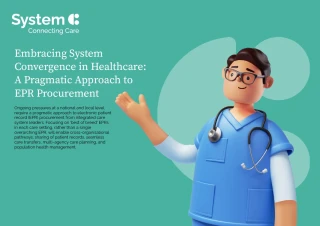Convergence Blog Part Two: Acute EPR Convergence - Are We Beginning with the End in Mind?
22nd January 2024
In our second blog on electronic patient record (EPR) convergence, we look at how investment in health and care technology must support the immediate and future needs of both if it is to provide tangible and sustainable benefits for all.
In our initial blog on EPR convergence, we highlighted how the majority of patient flow does not occur between acute hospitals. Despite this, most of the technology investment is currently focused on converging acute EPRs.
While such investment in digitising hospitals is important, neglecting other parts of the system, particularly social care, will further perpetuate an imbalance in health and care provision and undermine productivity across the whole system.
Impact of Social Care on NHS Productivity
The impact the provision of social care has on the NHS is well documented with tens of thousands of people admitted for social care reasons or remaining in hospital waiting for social care provision on a daily basis.
While access to social care services is likely to remain an issue for the foreseeable future, there is huge room for improvement in the processes that help prevent admissions and expedite discharges that are not currently addressed by the convergence agenda.
Expediting Discharge
As an example, the ‘Discharge to Assess’ process is complex for ICSs to manage, with care teams often sitting across acute, community and social care providers. Their core operational systems focus on individual organisational workflows and not those that span multiple organisations.
As a result, ICSs turn to spreadsheets, emails, conference calls and messaging apps to help coordinate care. This leads to inaccurate information, duplicate data entry and delays in communication, with the net result of significant delays in the process of expediting discharge.
While there has been progress in sharing information between care settings through shared care records, this hasn’t improved cross organisational workflows or helped join up care teams around the needs of their patients beyond a few isolated examples. University Hospitals Bristol and Weston, for example, connects care teams across Acute, Community and Social Care Services to improve the safety and efficiency of the discharge process.
The digital tools that are needed all need to function seamlessly across multiple organisations. These include shared patient pathway management, visibility of patient status within any care setting, notifications of patient events across multi-disciplinary care teams and task management and team messaging, linked to the patient record.
Preventing Admissions
On the other side of the equation, some regions are making significant progress in using population health and remote monitoring to help prevent admissions. Frimley ICS is often cited as an exemplar. This is vital progress in moving to proactive care models and delivering a sustainable NHS. Again, maximum benefit is derived when this capability is an integral part of the acute EPR.
Acute EPR Convergence to Meet Current and Future Needs?
While acute EPR technology investment will help enable more efficient, better-quality care within the hospital, it doesn’t necessarily deliver the building blocks for more joined-up care such as ‘Discharge to Assess’. The risk is that we may meet some of the current needs of hospitals but not address the future needs of the NHS and the population it serves.
There are many people who believe that part of the solution to delivering a sustainable NHS is to better integrate health and social care. While progress has been challenging and slow, one way of making a difference would be to better connect clinicians and social workers with cross-organisational workflows and digitise the end-to-end processes that matter. This in turn would provide data and a deeper understanding of these crucial processes.
An acute care setting may only cater for 20% of an individual’s care journey, but its impact goes beyond the hospital. A suitable EPR technology investment can meet the urgent needs for more productive care in the hospital and provide a building block for more joined-up care.
The Health and Social Care Technology and Investment Gap
The NHS and social care have significant differences in technology investment. The NHS was promised over £2bn in tech investment in 2021, albeit these plans were revised in 2022 to cover shortfalls created by pay reviews. In comparison, social care was given £100m over two years.
Such disparities will prove challenging for ICS digital leaders and particularly those with a real focus on integrating health and social care. However, it is through careful planning and collaboration that solutions will emerge.
Convergence with the End in Mind
Social care is the care setting that Integrated Care System (ICS) leaders must not forget as part of their digital plans.
Several ICS plans outline the need for EPR convergence within individual care settings. A ‘one-size-fits-some’ approach that is pragmatic should bring benefits such as standardised care processes and workflows and more empowered staff. But as ICSs work towards more integrated practices for shared care we should also be focusing on convergence of workflows that join up health and social care.
Read our ebook on EPR convergence for further insight into this important topic:
Read eBook


